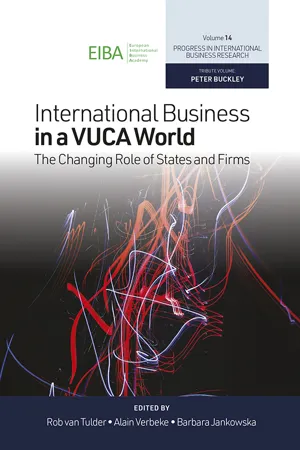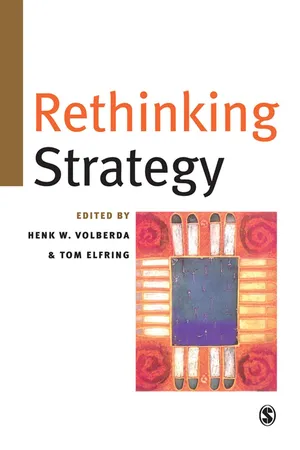Business
Ability
Ability refers to the skills, knowledge, and expertise that an individual possesses to perform a particular task or job. It is an essential factor in determining the success of an individual or an organization. The ability of an individual can be developed through training, education, and experience.
Written by Perlego with AI-assistance
Related key terms
4 Key excerpts on "Ability"
- eBook - ePub
International Business in a VUCA World
The Changing Role of States and Firms
- Rob van Tulder, Alain Verbeke, Barbara Jankowska(Authors)
- 2019(Publication Date)
- Emerald Publishing Limited(Publisher)
Here, knowledge acquisition, or the Ability of a firm to identify and absorb new external knowledge, together with knowledge assimilation, or the Ability to analyze, process, interpret, and understand the newly acquired knowledge, are the two main capabilities that enable organizations to continuously renew their knowledge stock, therefore enhancing their receptivity to understanding and evaluating valuable external knowledge and providing them with the strategic flexibility to adapt within different contexts (Enkel & Heil, 2014). By actively and continuously developing these capabilities, a firm builds its potential absorptive capacity. Comparatively, knowledge transformation, or the Ability to refine and combine existing knowledge and assimilated knowledge, along with knowledge exploitation, or the Ability to incorporate the transformed knowledge into operations to enhance existing competencies or develop new ones, allow firms to derive new insights and gain short-term profits from utilizing existing and newly acquired and assimilated knowledge (Volberda, Foss, & Lyles, 2010 ; Zahra & George, 2002). Considering the employees are the ones who possess valuable knowledge and the Ability to continuously enhance it for the creation and implementation of innovative ideas and products (Kiessling & Harvey, 2006 ; Latukha, 2018) the concept of absorptive capacity should be investigated through the lenses of human resource management and talent management. Absorptive capacity can be determined as an organization-level construct, consisting of two key elements that can lead to high firm performance: an employee’s Ability, which is positively related to competence/performance appraisal and training, and an employees’ motivation, which is positively related to performance-based compensation, merit-based promotion, and internal communication (Minbaeva, Pedersen, Björkman, Fey, & Park, 2003) - eBook - ePub
- Anthony Mann, Prue Huddleston, Elnaz Kashefpakdel(Authors)
- 2018(Publication Date)
- Routledge(Publisher)
Competences are largely understood to be both supply-side driven and demand-orientated. The competences which educational institutions provide are seen to have a utility in the market, serving as productive resources in meeting economically efficient ends. Employee competences, sometimes defined more broadly in literature as professional competences, are developed within education and training contexts and then applied into workplaces in ways that enhance both individuals’ and organisations’ productive advantage (Mulder et al. 2009). At an individual level, definitions of competences are often framed around the ways in which people draw upon formally or informally acquired learning which enables them to perform to, or exceed, demanded expectations in a work context. When considering what specifically constitutes competence at an individual level, attention has focused on individuals’ functional capacities in terms of what an employee may be expected to execute towards the purposive end of fulfilling tangible job-related demands. Le Deist and Winterton (2005) have broken competences into three dominant categories: functional, cognitive and social competence. Functional competence is typically linked to technical performance and is oriented towards specific occupational tasks that enable the competence to be effectively executed. It is underpinned by broader sets of cognitive competences relating to individuals’ knowledge (codified and tacit), conceptual understanding and other internal abilities which enable them to execute job-related tasks. Social competences are those which relate to the appropriate channelling of behaviours and attitudes towards desired outcomes - eBook - ePub
- John Stephenson, Mantz Yorke(Authors)
- 2013(Publication Date)
- Routledge(Publisher)
Higher Education for CapAbility (HEC) was established by the RSA in 1988 to take these issues into the senior common rooms of the UK and, via its members overseas, to higher education in Australia and New Zealand. Through extensive discussions of the manifesto and its relevance in over 100 higher education institutions, HEC found considerable agreement for the development of student capAbility as an appropriate aim of higher education. The aim of this chapter is to explore the concept of capAbility more fully, to set capAbility in its wider context and to set out some of the issues facing higher education in its delivery.The concept of capAbilityCapAbility is an all round human quality observable in what Sir Toby Weaver describes as ‘purposive and sensible’ action (Weaver, 1994). CapAbility is an integration of knowledge, skills, personal qualities and understanding used appropriately and effectively – not just in familiar and highly focused specialist contexts but in response to new and changing circumstances. CapAbility can be observed when we see people with justified confidence in their Ability to:- take effective and appropriate action;
- explain what they are about;
- live and work effectively with others; and
- continue to learn from their experiences as individuals and in association with others, in a diverse and changing society. (Stephenson, 1992)
Each of these four ‘abilities’ is an integration of many component skills and qualities, and each Ability relates to the others. For instance, people’s Ability to take appropriate action is related to specialist expertise which in turn is enhanced by learning derived from experiences of earlier actions. Explaining what one is about involves much more than the possession of superficial oral and written communication skills; it requires self-awareness and confidence in ones specialist knowledge and skills and how they relate to the circumstances in hand. The emphasis on ‘confidence’ draws attention to the distinction between the possession and the use of skills and qualities. To be ‘justified’, such confidence needs to be based on real experience of their successful use. In association with others in unfamiliar - eBook - ePub
- Henk W Volberda, Tom Elfring(Authors)
- 2001(Publication Date)
- SAGE Publications(Publisher)
Second, distinction is made between resources and capabilities. Resources are defined as stocks of available factors owned or controlled by the firm (Amit and Schoemaker, 1993). CapAbility, on the other hand, refers to the capacity for a team of resources to perform some task or activity (Grant, 1991). Capabilities are firm specific, and developed over time, through complex interactions among resources (Amit and Schoemaker, 1993; Bogaert et al., 1994; see also Sanchez, Chapter 13, this volume). While most authors assert that firms do not have just one core competence but a whole portfolio of competencies and capabilities, there is no common conception of how these link to each other. Turner and Crawford (1994: 243) distinguish between management competencies and technical competencies. In the case of the former, we are concerned primarily with the technological aspects of the creation, production and delivery of the organization’s products and services. In the case of the latter, in turn, we are referring to the ‘direction, development, motivation, control and integration of the organization’s performance’. Tampoe (1994: 69) argues that competencies are often hierarchical. A holding company, for example, may have core competencies that make it successful in managing a diversified business while the different companies within the group will have specific core competencies that are alien to the holding company. On the basis of the above, it can be concluded that the management of the firm’s competencies is a critical competence per se (Prahalad and Hamel, 1990: 81; Roos and von Krogh, 1992: 425). The competencies of the individual managers as well as the organizational practices of strategic management constitute the firm’s ‘strategic management capAbility’ (see Normann, 1985) that may also be considered a meta-level of the firm’s competence portfolio
Learn about this page
Index pages curate the most relevant extracts from our library of academic textbooks. They’ve been created using an in-house natural language model (NLM), each adding context and meaning to key research topics.



